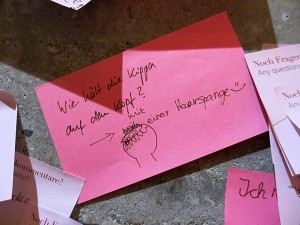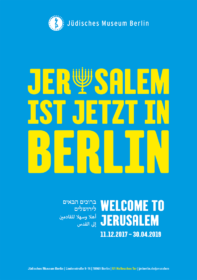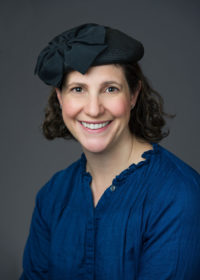“How does a kippah stay on?”
Our current special exhibition “The Whole Truth… everything you always wanted to know about Jews” is based on 30 questions posed to the Jewish Museum Berlin or its staff over the past few years. In the exhibition, visitors have their own opportunity to ask questions or to leave comments on post-it notes. Some of these questions will be answered here in our blog. This month’s question is: “How does a kippah stay on?”

“How does a kippah stay on?”
© photo: Anina Falasca, Jewish Museum Berlin
If a non-Jew tries on a kippah, it usually falls off. This isn’t fair, but let’s examine the circumstances more closely. When tourists visit the Jewish cemetery in Prague, all men are asked to wear a kippah. Those who travel kippah-free are requested to don a blue, sharply-creased, circular piece of paper. The precarious kippah is inevitably subjected to the winds off the Vltava and flutters away. Comparably, a non-Jewish man attending a synagogue ceremony such as a marriage or Bar Mitzvah, will usually be requested to wear a kippah. Here, a stiff yet slippery synthetic satin kippah is ubiquitous. No guest stands a chance.
What then is the secret to making a kippah stay on? (more…)
How school children react to the tour through the exhibition Welcome to Jerusalem. A conversation with Marc Wrasse

Campaign for the exhibition Welcome to Jerusalem; Jewish Museum Berlin, designed by: Preuss und Preuss GmbH
You’ve worked for the Jewish Museum Berlin for many years, as well as for other museums. What makes this exhibition special?
The Jewish Museum Berlin has a wide variety of visitors—the audience here is nearly as diverse as the modern world itself. If you visit the museum or work here, you can have a lot of different experiences, including in experimental exhibitions such as Obedience (more information about the exhibition on our website). Due to their social and political significance, I always find encounters during tours through Welcome to Jerusalem (more on our website) to be something special. Muslim students in particular—and that label encompasses much variety, ranging from the third-generation Turkish people in Germany to Syrian war refugees with their anti-Israeli background—are highly attentive in this exhibition.
Why is that, in your opinion?
(more…)
An Interview with Rabba Sara Hurwitz

Rabba Sara Hurwitz; photo: Poppy Studio
In 2009 Rabba Sara Hurwitz became the first Orthodox woman to be ordained at the Hebrew Institute of Riverdale. In the same year, together with Rabbi Avi Weiss, she founded Yeshivat Maharat, the first Orthodox seminary to ordain women as clergy—full spiritual and halakhic leaders. Today, Yeshivat Maharat offers a dynamic group of women the opportunity to become ordained clergy within the bounds of halakha. It is not surprising that, when asked about which revolution she admires, Rabba Hurwitz’s answer is: “The women’s liberation movement, especially in the 1960s and 70s, which helped the world come to terms with the notion that 50 percent of the population‒‒women‒‒have equal abilities, talents, and passion to contribute to society.”
We asked her about female spiritual leaders, the #metoo movement, and the digital revolution: (more…)


